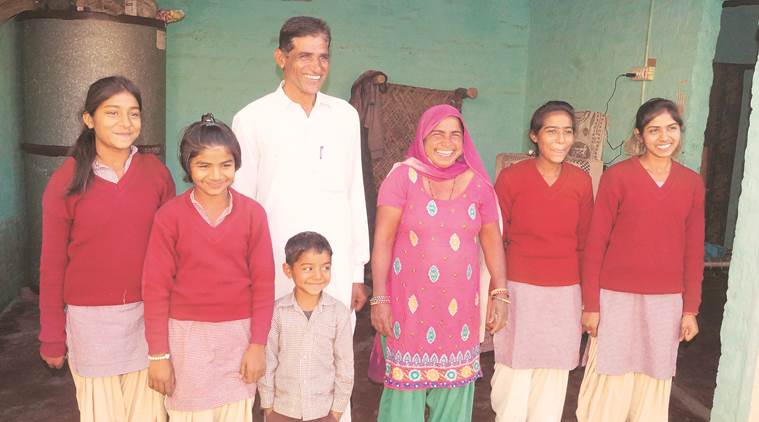Balwant Kasania occasionally forgets the names of all his granddaughters. The farmer, who owns 13 acres at Nathusari Kalan village in Haryana’s Sirsa district, has seven, apart from one grandson from his son Mahender Singh. “I don’t know who else is after Manisha, the fourth granddaughter,” smiles Kasania.
However, he remembers the name of the last granddaughter. “Her actual name is Vijay Lakshmi, but we have given her the nickname ‘Badho’, which means ‘it’s enough’,” adds the 72-year-old, now laughing. “We threw open our doors for all the daughters.”

In March 2016, Nathusari Kalan was awarded Rs 1.5 lakh by the Haryana government for improvement in its sex ratio at birth. The money was given to Poonam, Vandana and Jyoti, the top-scorers among the Class 10 girl students of the village in 2015.
Story continues below this ad
As many as 61 girls were born to 42 boys in Nathusari Kalan in 2015, a sex ratio of 1,452. It was 852 in 2013 and 949 in 2014. As Haryana celebrates achieving 900 in sex ratio at birth for the first time in 15 years, Nathusari Kalan and the entire Sirsa are among its foremost success stories. The district, located close to the Rajasthan border, has ranked highest in Haryana on the score for the past two years, and between 2015 and 2016 alone, saw the ratio jump from 915 to 935.
In the 2011 Census, the sex ratio at birth in the state (0-6 years) was the lowest in the country, at 834 girls against 1,000 boys. The figures for 2016 are provisional, collated by the Haryana Health Department.
Balwant Kasania is candid, “None of us go in for a sex determination test. It is the only reason for improvement in the sex ratio.”
His neighbour Devi Lal, a father of five, including Jyoti who received the award from the state government, says his relatives urged him to get a sex determination test done. “But I said no. I did not want to be part of a sin.” A Dalit who is a member of the village panchayat, Devi Lal talks proudly of Jyoti’s achievements.
Story continues below this ad
There is only one ultrasound centre in the area, in a village adjacent to Nathusari Kalan, but it is not functional without a radiologist. Deputy Civil Surgeon of Sirsa district Dr Viresh Bhushan says, “We have ensured that no female foeticide incident takes place in the area.”
“The strict implementation of the PCPNDT (Pre-Conception and Pre-Natal Diagnostic Techniques) Act has played a significant role in the improvement of the sex ratio,” adds Dr Parveen Kumar Garg, Director General, Health Services, Haryana.
Since the launch of the Beti Bachao Beti Padhao programme by Prime Minister Narendra Modi from Panipat in January 2015, state officials say, there has been a massive drive against sex selection, selective abortion and female foeticide, involving inter-district raids as well as at least 75 raids across the border in adjoining states such as Delhi, Punjab, Uttar Pradesh and Rajasthan.
About 400 FIRs have been registered under the PCPNDT and Medical Termination of Pregnancy Act in this period, including for sale of drugs “to ensure birth of a male child”. With khap panchayats also putting their weight behind the campaign, announcing that they would socially boycott people involved in female foeticide, the trickle effect is visible in Nathusari Kalan.
Story continues below this ad
Balwant and Prabhu Dayal Soni, who has a jewellery shop in the village, say houses with no girl child are seen with suspicion. “Girls are important for a healthy society. Enhancement of a society is not possible without women,” says Soni.
Rajesh Kasania, a local activist, says one crucial difference has been made by the fact that girls in Nathusari Kalan don’t have to go out of the village to study. Most families don’t want to send their daughters too far to school or college, for fear of their safety.
“In the radius of 20 km, only this village has a senior secondary school for girls apart from an Aarohi School, meant for talented children,” Rajesh says, pointing out that this helps families not to see daughters as burden. Aarohi Schools have been set up in 36 blocks in the state identified as educationally backward over the past few years, including in all the six blocks of Sirsa district.
Principal of Nathusari Kalan’s Aarohi School Ramesh Kumar says that one of their students, Sahukar, stood first in the district in Class 12 exams of the Haryana Board of School Education and got admission in Delhi University. Of the three girls who scored the most in Class 10 exams in the village in 2015, Poonam and Vandana now study in the Aarohi School, after clearing a competitive exam. The third, Jyoti, is in Class 12 in the village Government Girls’ Senior Secondary School.
Story continues below this ad
Talking of the film Dangal, based on the successful Haryana wrestler sisters Geeta and Babita Phogat, Rachna Rani, a 20-year-old of Nathusari Kalan, says, “It’s like the story of our family, where our father is the role model for us sisters.” Rachna is one of five daughters of Banwari Lal Saharan, with their youngest sibling a brother, Nitin, 14. “We never faced any discrimination. My father always encouraged us to go in for higher studies,” says Rachna, who is preparing for competitive exams after completing Master’s in Computer Applications. Three of the sisters hold master’s degrees while the youngest, Reeta, is doing MBBS at a private institute in Sirsa.
However, not all has changed. In family after family in Nathusari Kalan, it is clear that while girls are no longer unwelcome, a family is considered complete only with a boy.
Balwant Kasania’s wife Parmeshwari Devi, 70, admits they “used to often shed tears when a girl was born but danced when our bahu (daughter-in-law) was blessed with a son”. “We distributed sweets.” The Kasania family says they went to a saint for a son.
“Who will care for parents if there is no boy in the family, as girls have to go to their in-laws later or sooner?” says Kaushalya Devi, 50, Balwant’s daughter-in-law. Even her daughter Anita, 20, agrees. “Yes, without a boy, it is difficult.” Jyoti, 17, who got Rs 30,000 from the state government for scoring 81.4 per cent in Class 10, earning her the third position among girls in Nathusari Kalan, says, “A son is necessary to carry on the family tree.”
Story continues below this ad
The principal of the Government Girls’ Senior Secondary School she goes to, Shri Ram, says only around 20 per cent of the village girls pursue higher education after schooling. “Further, half of these 20 per cent do it through the distance education programmes of different universities.”
Rachna’s mother Saroj Devi adds that while she loves all her daughters, “in villages, a son is mandatory”.
Their father Banwari, 60, admits he worries about arranging dowry for his five daughters. “Dowry is deep-rooted here. I have 20 acres of land but it doesn’t produce much because of waterlogging. If the government is serious about the welfare of girls, it must ensure more jobs for them. Despite higher education, none of my daughters has got a decent government job till now,” he says. In another corner of the village, a gram sabha meeting has started. The sarpanch is a Dalit woman, 27-year-old Deepa Rani. But during the two-hour-long meeting, Deepa, her face covered with a veil, doesn’t say a word, even as her husband Tulsi Ram conducts the proceedings on her behalf.
Of the six women members of this panchayat, only one, Sumitra Devi, has turned up for the gram sabha. When asked why the other women members had not come, the husband of a member says, “It’s not a bazaar (where one displays things), but a village.”
Story continues below this ad
The smile still on his face, Balwant Kasania with the seven granddaughters wonders what it would have been like if he had seven buffaloes instead. “We would have been wealthy. Each buffalo is worth Rs 60,000.”

 Devi Lal has five daughters, including Jyoti who received an award from the state government for doing well in her Class 10 exams in 2015. Express
Devi Lal has five daughters, including Jyoti who received an award from the state government for doing well in her Class 10 exams in 2015. Express






